Since 1909, the US Mint has produced more than 450 billion Lincoln pennies. The lowest production year was 1922, with just 7 million coins made, while the highest was 1982, when a whopping 17 billion pennies were minted. Generally, older coins tend to carry more value.
Given that 1998 pennies are relatively recent—about 25 years old—you can expect their value to be fairly modest. However, some rare examples have sold for impressive amounts at auctions, so it’s always worth inspecting your pennies carefully. You never know what you might find!
1998 Penny Value Chart
| Condition | 1998 No Mint Mark Penny | 1998 Wide AM Penny | 1998 D Penny | 1998 S Penny | 1998 S Close AM Penny |
|---|---|---|---|---|---|
| MS 65 | $4 | $27 | — | — | — |
| PR 65 | — | — | — | $4 | $145 |
*Note: Values refer to brown-graded coins.
History of the 1998 Penny

The US Mint introduced the first Lincoln pennies in 1909 to commemorate the 100th anniversary of Abraham Lincoln’s birth, honoring this iconic American president. Originally known as Wheat pennies due to their reverse design, these coins were redesigned in 1959 to mark Lincoln’s 150th birthday.
1998 Penny Variations
| Mint Location | Coin Type | Number Minted |
|---|---|---|
| Philadelphia | 1998 No Mint Mark Penny | 5,032,155,000 |
| San Francisco | 1998 S Penny (Proof) | 2,086,507 |
| Denver | 1998 D Penny | 5,225,353,500 |
| Total | 10,259,595,007 |
The pennies produced in 1998 are among the final issues of the Lincoln Memorial reverse design before the introduction of four different reverse designs in 2009. Interestingly, the artist Frank Gasparro, who created the Memorial design, never actually saw the monument himself — a fact that led some of his peers to question the artistic quality of his work.
Features of the 1998 Penny
The obverse of the 1998 Penny
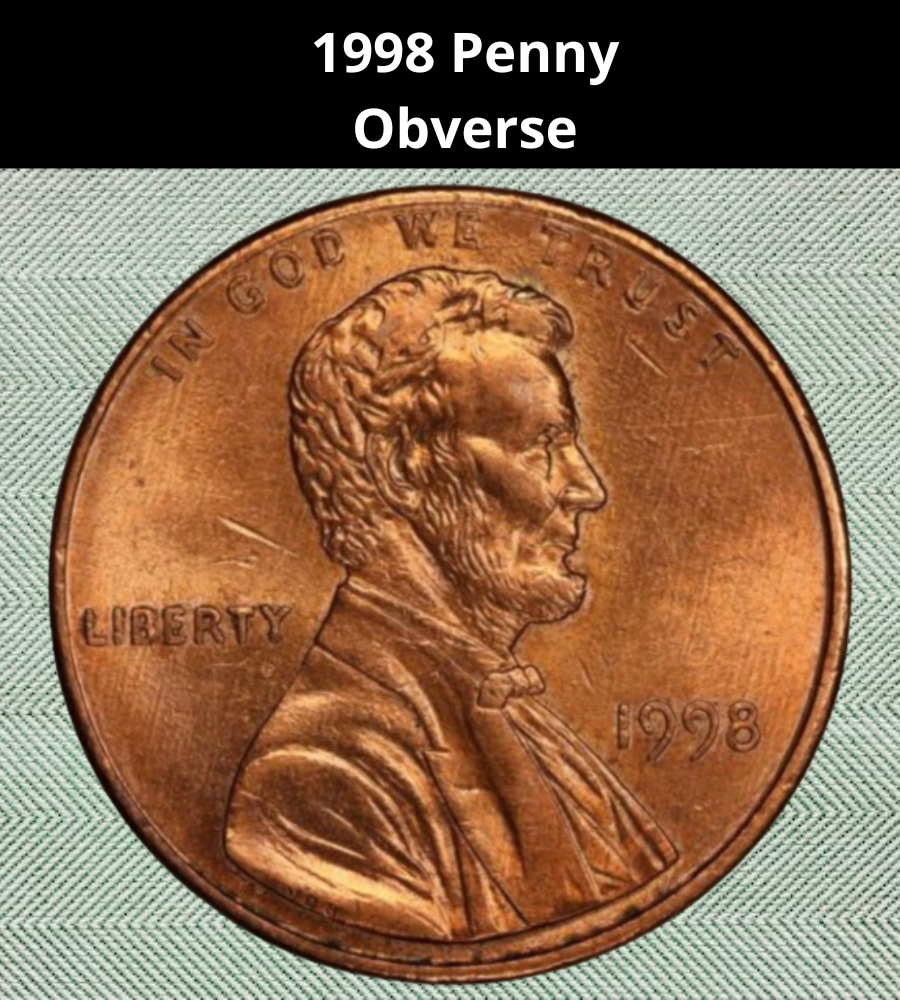
The front (obverse) of the penny has stayed the same since its introduction in 1909. So, the 1998 pennies still feature the classic Lincoln portrait at the center, along with four key inscriptions: IN GOD WE TRUST across the top, the minting year, the initials VDB for the designer Victor David Brenner, and LIBERTY to the left of Lincoln’s image.
The reverse of the 1998 Penny
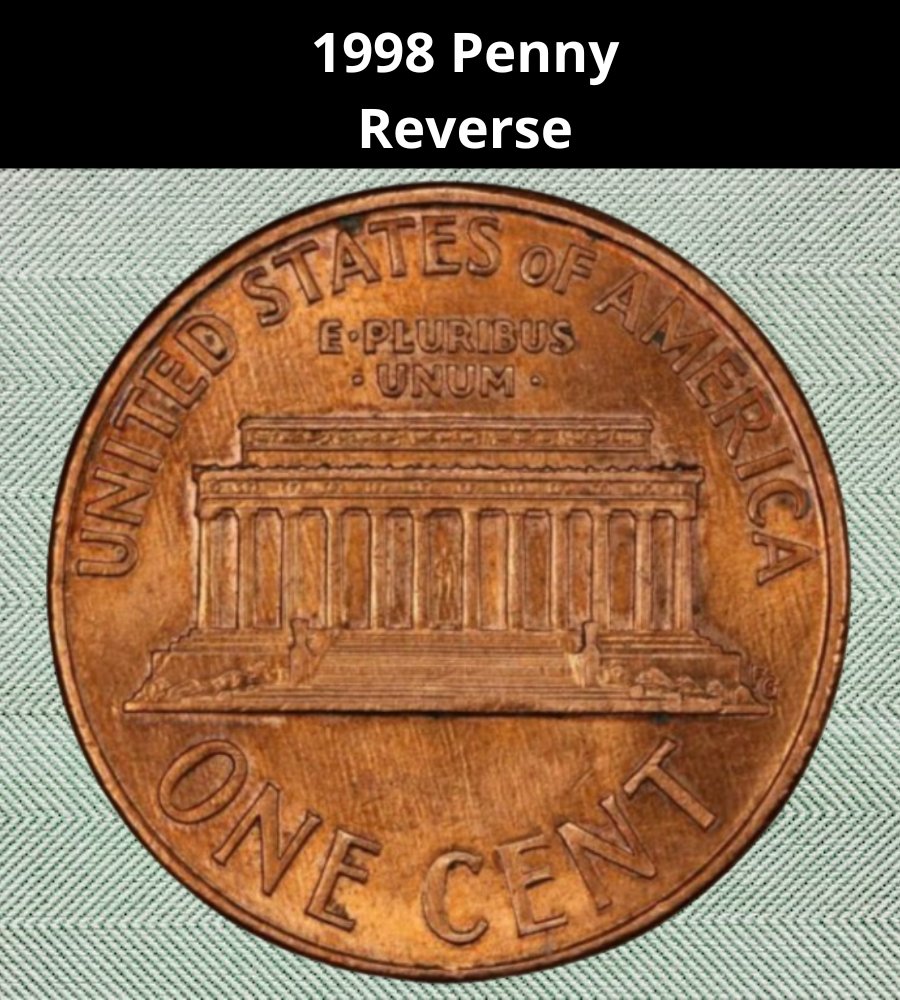
The back of the 1998 Lincoln penny features the iconic Lincoln Memorial, prominently centered with its rows of pillars and a small statue of President Lincoln visible inside. Surrounding the image are the usual inscriptions: UNITED STATES OF AMERICA, the initials FG for designer Frank Gasparro, ONE CENT indicating the coin’s value, and the motto E PLURIBUS UNUM.
1998 Penny Specifications
- Face Value: One cent ($0.01)
- Shape: Round
- Composition: Since 1982, pennies are made of 97.5% zinc with a 2.5% copper plating
- Weight: 2.5 grams (0.08818 ounces)
- Thickness: 1.52 mm (0.05984 inches)
- Diameter: 19.05 mm (0.75 inches)
- Edge: Smooth/plain edge
Additional Characteristics of the 1998 Penny
Similar to all Lincoln pennies produced after 1982, the 1998 version is composed of 97.5% zinc with a thin copper plating of 2.5%. Each coin weighs approximately 2.5 grams (0.08818 ounces) and measures about 1.52 mm (0.05984 inches) in thickness. These one-cent coins feature a smooth, plain edge and have a diameter of 19.05 mm (0.75 inches).
Grading the 1998 Penny
To determine the true value of your 1998 pennies, it’s important to grade them using the Sheldon grading scale. For most modern pennies, this can be done on your own since they typically don’t hold high value, making professional grading unnecessary.
Professional grading becomes worthwhile only if you believe your coin has a rare error or exceptional qualities that could significantly increase its value. In those cases, investing in an expert assessment might pay off.
Here’s a simplified overview of the grading scale:
| Grade Number | Description |
|---|---|
| 1 | Basal State |
| 2 | Fair |
| 3 | Very Fair |
| 4, 5, 6 | Good |
| 7, 8, 10 | Very Good |
| 12, 15 | Fine |
| 20, 30 | Very Fine |
| 40 | Extremely Fine |
| 50 | About Uncirculated |
| 60 | Mint State |
| 65 | Mint State |
| 70 | Mint State (Perfect) |
For the most accurate valuation, refer to detailed grading guides to correctly place your coin on the scale. This step is essential to understand your coin’s exact worth.
The 1998 Penny Value Guides
1998 No Mint Mark Penny Value
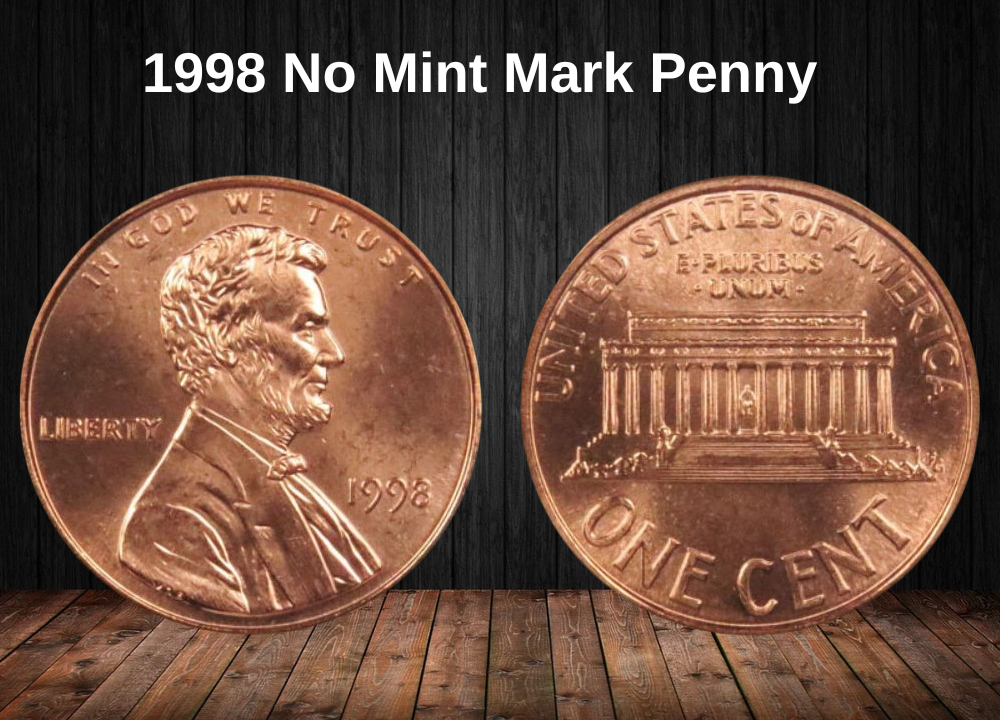
The Philadelphia Mint produced 5,032,155,000 pennies in 1998, a typical figure for coin sets from the 1990s. These coins remain widely circulated, and even those in mint condition are fairly common. Because of this, collectors usually focus on pennies with red toning, which tend to be more desirable.
Most well-preserved examples are valued between 10 cents and $13, with only those graded MS 68 commanding higher prices, around $190. However, some special coins have fetched much greater amounts at auctions.
For example, a red-brown 1998 penny graded MS 66 sold for $125 on eBay in 2021, while a brown penny graded MS 69 went for $420 three years earlier.
The most remarkable sale occurred in 2020 when a red 1998 penny in MS 69 condition set a record by selling for $5,800, making it the priciest coin from that year’s collection.
1998 D Penny Value
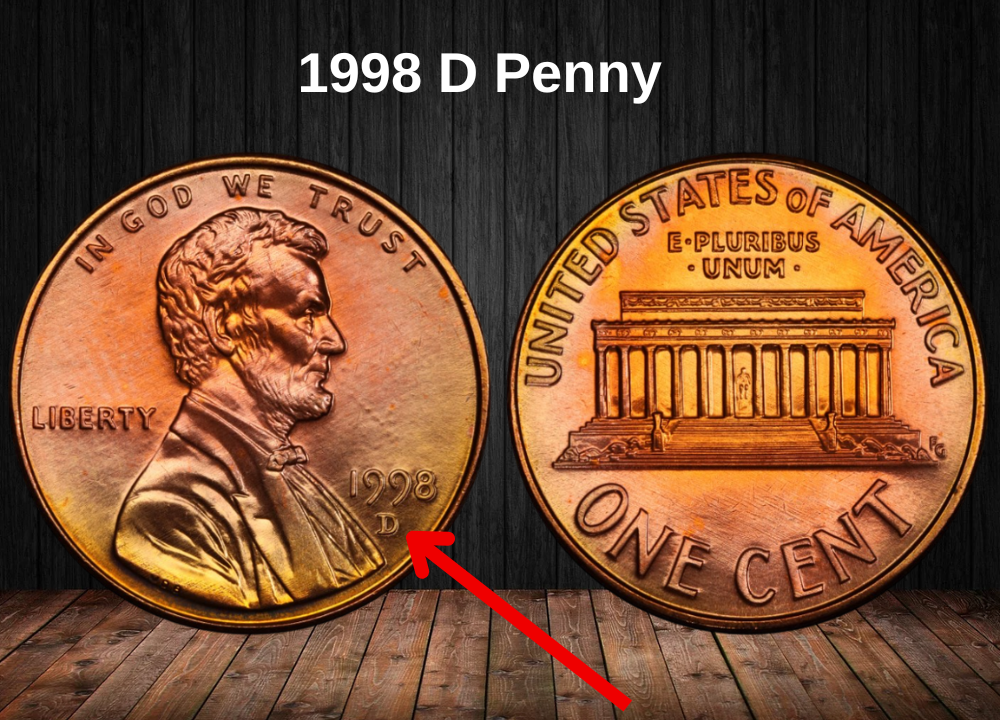
The 5,225,353,500 pennies produced at the Denver Mint in 1998 remain quite affordable today. Red-toned examples typically range from around $3 for coins graded MS 63 up to about $50 for those graded MS 67. Coins with an MS 68 grade can reach values near $250. Interestingly, the most valuable 1998 Denver penny known is an MS 66 specimen that sold for $529 back in 2011.
1998 S Penny Value (proof)
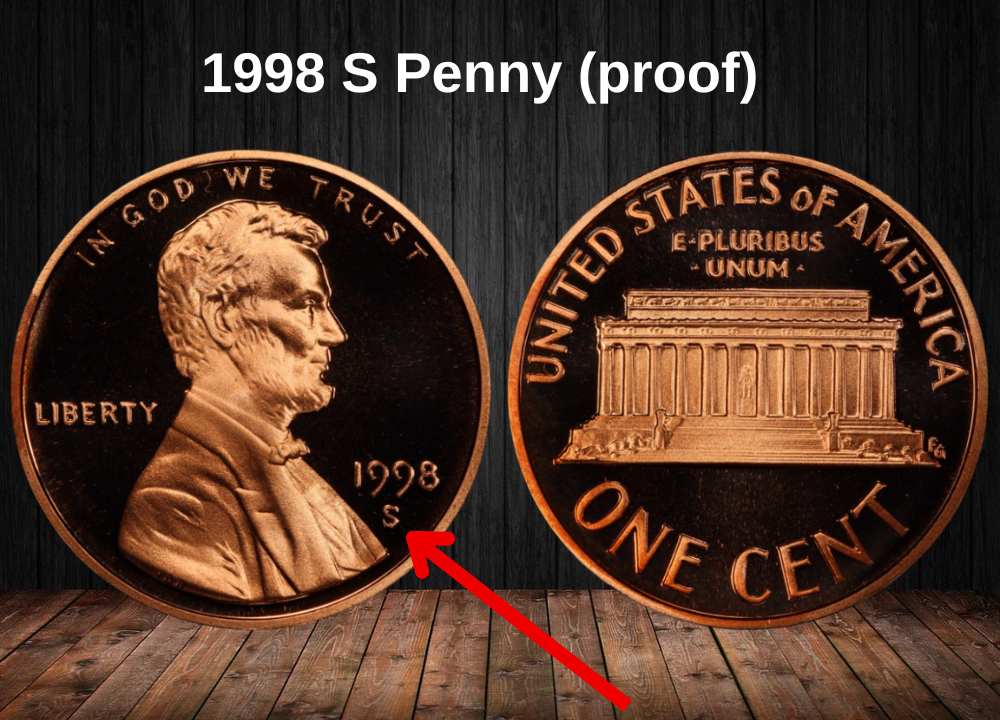
In 1998, the San Francisco Mint produced only proof pennies, totaling 2,086,507 coins marked with an “S” beneath the date on the front. These coins were made primarily for collectors, with the most desirable examples being red-toned specimens featuring a strong cameo contrast.
Proof pennies graded between PR 60 and PR 65 typically sell for $1 to $4, while those graded from PR 66 up to PR 69 can command prices between $5 and $14. However, exceptions exist: a flawless DCAM (Deep Cameo) penny graded PR 70 sold for $1,265 in a 2005 auction, demonstrating the premium collectors place on pristine condition.
Rare 1998 Penny Errors list
Close AM
Among the 1998 proof pennies, a few feature the distinctive Close AM variety. Since the U.S. Mint intended collectors’ coins to be struck with the Wide AM die, these Close AM coins are considered mint errors.
Collectors can typically find a 1998 DCAM red Memorial proof penny graded between PR 66 and PR 69 valued from $160 to $260. However, auction results have shown much higher prices: two PR 70 Close AM pennies sold on eBay for $4,500 in 2015 and $4,000 in 2018.
Wide AM
Typically, 1998 regular strike pennies feature the “Close AM” style, where the letters in “AMERICA” are closely spaced. However, some coins show the “Wide AM” variation, where the letters are noticeably farther apart.
This happened because the Wide AM reverse die—normally reserved for proof coins—was accidentally used on some regular strike pennies. Circulated coins with the Wide AM error usually sell for around $10, while uncirculated examples can fetch between $15 and $25.
The most valuable Wide AM pennies from 1998 are red-toned specimens that have sold at auction for $940 in 2014 and $725 in 2011. Brown-colored examples with this error are less costly but have reached auction prices between $175 and $250. Red-brown coins with the Wide AM variety typically sell for $30 to $80.
Doubled Die
Coins with this error show a noticeable doubling effect on certain details—such as numbers, letters, or images—usually on one side. This happens because the die used to strike the coin was accidentally made with a doubled design.
On 1998 pennies, the doubling often appears subtly around Lincoln’s eye, his bowtie, some letters, or the pillars of the Memorial. In most cases, the doubling is slight and can only be seen clearly with a magnifying glass. These error coins generally sell for between $20 and $50.
Off-center
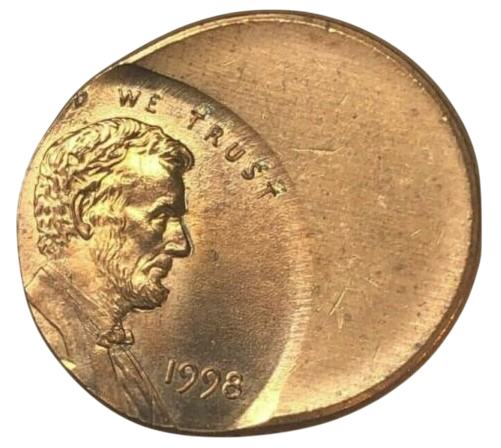
This error occurs when the coin’s blank planchet isn’t properly aligned before being struck, or when the dies themselves are misaligned. Minor off-centering—between 3% and 10%—is quite common and usually doesn’t add much to the coin’s value.
However, 1998 pennies with an off-center strike ranging from about 5% to 10% can be valued around $5 to $15. The most sought-after examples are those with extreme off-centering, between 45% and 60%, which collectors prize highly and typically sell for $50 to $100.
BIE Die Crack
This particular error is common among many pennies in this series due to a crack forming on the die right through the middle of the word “LIBERTY.” As a result, the inscription can appear distorted, sometimes reading as “LIBIERTY.” While certain older examples of this error can be valuable, modern pennies like those from 1998 don’t carry much premium for this flaw.
Typically, coins showing this BIE die crack sell for a modest $10 to $15. Some collectors have also noted 1998 no-mint-mark pennies with an IIB error, which is a usual occurrence for this year and generally holds little additional value.
Where to sell your penny?
Now that you know the value of your penny, you might be wondering where to sell it. Don’t worry: here’s a guide to some of the best online platforms where you can easily sell your coins, along with their advantages and disadvantages.
Discover the best platforms for selling coins online (pros and cons).
FAQ about the 1998 Penny
1. What is the composition of the 1998 penny?
The 1998 penny consists of a zinc core (97.5%) with a thin copper plating (2.5%), consistent with the composition used since 1982.
2. Which mints produced the 1998 penny?
The 1998 penny was minted at Philadelphia (no mint mark), Denver (“D” mint mark), and San Francisco (“S” mint mark) for proof coins.
3. Are there any notable error coins or varieties from 1998?
Yes, some known errors include doubled dies, off-center strikes, and die cracks. While these errors are not extremely rare, they are prized by error coin collectors.
4. What design is featured on the 1998 penny?
The obverse shows Abraham Lincoln’s portrait by Victor D. Brenner, and the reverse depicts the Lincoln Memorial, the design used from 1959 to 2008.
5. How common is the 1998 penny?
The 1998 penny is very common with billions minted across Philadelphia and Denver, and millions of proof coins from San Francisco.
6. What is the average market value of a 1998 penny?
Most circulated 1998 pennies are worth face value. Uncirculated and proof pennies can range from a few cents to a couple of dollars, with error coins potentially fetching higher prices.
7. Are 1998 pennies good for investment?
Generally, common 1998 pennies are not considered good investments. However, error coins and high-grade proof or uncirculated examples may have collectible value.


















































